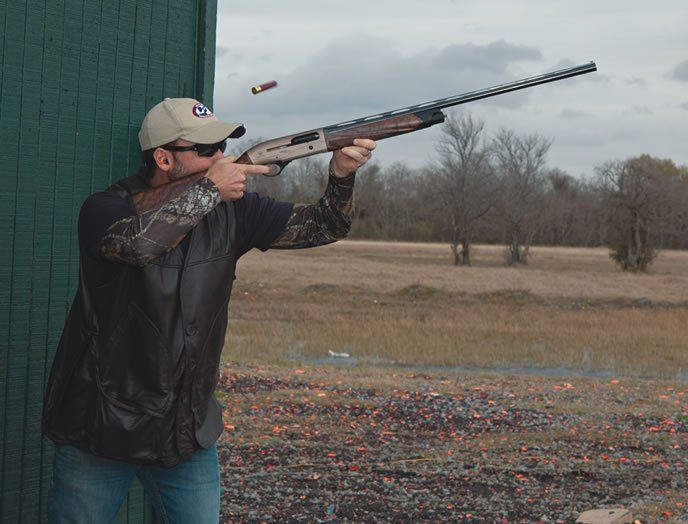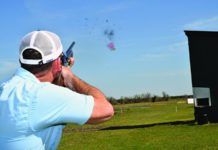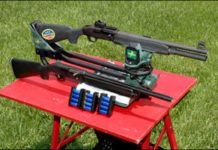Skeet shooting is probably the most popular of all shotgun sports, perhaps because in the opinion of many dedicated upland-bird hunters, skeet is the game that offers the most realistic preparation for a day in the field. This alone may be reason enough to play, but for anyone who has tried big-time tournament skeet shooting, finding the right equipment can lead to sticker shock. Here’s why.

Skeet tournaments require at least four rounds of shooting with four different gauges of shotguns. If you’ve ever tried to sign up for a tournament expecting to compete in only the 12-gauge events, your entry will likely be relegated to a wait list behind all the competitors who are ready to shoot all four gauges. The serious tournament competitors must have a complete stable of shotguns, including 20 gauge, 28 gauge and .410 bore, as well as a 12 gauge. Some shooters opt to have their 12-gauge shotgun precision fit with tubes that convert the bore to fire the full list of smaller gauge rounds. But there’s another way to solve the problem, and it’s one that lead us to a whole new field of pleasure.

After learning that we could compete with a 20-gauge shotgun in the 12-gauge round and shoot the 20-gauge events with a 28-gauge shotgun, we decided to try shooting all but the .410 events with a 28-gauge shotgun. As a result we found out that we liked shooting 28-gauge shotguns a whole lot, specifically the semi-automatic ones. We chose to shoot a semi-automatic rather than an over-under shotgun for two reasons. First, top-quality semi-automatic shotguns are still much less expensive than many medium-priced over-under shotguns. Maybe its because less hand-craftsmanship and fitting is required. Second, we have a variety of people on staff, and semi-automatic shotguns are easier to fit. The angles of cast and drop on the semi-autos can be changed to suit each shooter quite easily with the use of shims and templates installed between the receiver and the buttstock. Furthermore, it is well known that recoil from 28-gauge ammunition is relatively mild, so fatigue or injury over the course of a long practice session is far less likely than from the effects of 12-gauge or even 20-gauge ordnance. That goes about double for the gas operated semi-automatic shotguns that bleeds pressure from ignition and dampens recoil.
The two semi-automatic shotguns we chose for this evaluation fit different ends of the price range in this category. The Turkish-made Pointer shotgun is imported by Legacy Sports International of Reno, Nevada and carries a suggested retail price of $701, but typically sells for about $650. The Pointer line of shotguns, both semi-automatic and over/under, is not to be confused with the Japanese-made Charles Daly products of the same name from several years back.
The Beretta A400 Excel Action manufacturer’s suggested retail price was $1600, but we found one for $1398 MAP (Manufacturers Advertised Pricing) at the Pro Shop at American Shooting Centers in Houston. The Pointer was capable of chambering 3-inch as well as 2.75-inch shells, but the Beretta’s barrel listed only 2.75-inch loads. Otherwise, both guns featured gas operation, walnut stocks, alloy receivers, a rubber-like butt pad, 28-inch ribbed barrel with light-gathering fiber-optic beads, crossbolt safeties, and magazine cutoffs so the bolt need not be worked to empty the gun. A selection of five flush-fit choke tubes, including Full, Improved Modified, Modified, Improved Cylinder and Cylinder bore were supplied with the Pointer shotgun. The Beretta shipped with only three: Full, Modified and Cylinder bore chokes.
Tests were performed at American Shooting Centers. With six Skeet and Trap fields, a separate field offering 12 stations of “self-pull” throwers, and as many as five different Sporting Clays courses to choose from, we limited our shooting to rounds of 5-Stand and Skeet. Over the course of our tests, the 28-gauge semi-auto shotguns showed at least one advantage. With test shooters ranging from beginners to accomplished shooters, we can’t recall any of the missed targets being blamed on raising the head from the stock prematurely due to flinch, a bad shooting habit commonly driven by heavy recoil.
Before heading to our first shooting station, we patterned each shotgun with three test loads. They were Fiocchi 28GT8 2.75-inch No. 8s, Winchester Super Sport 2.75-inch No. 9s, and Estate 2.75-inch No. 7s. The Estate Super Sport Competition Target Loads were rated at a velocity of 1200 fps. The Fiocchi and Winchester boxes listed velocities at the 1300 fps mark. Patterning was performed at 20 yards with a Modified choke tube installed. Three consecutive shots were registered on each target.
Neither shotgun malfunctioned during our tests, so we had to wonder in what other way might one gun earn its spot above the other. Given the difference in price between our two test guns, we think it’s natural to expect the more expensive gun to excel. But how noticeable would the difference be, and where would such aspects first appear? Let’s find out.

Beretta A400 Xplore Action Semi-Auto J40AA88 28 Gauge, $1550
The Beretta shotgun arrived in a lockable takedown hard case that was well made but was probably not substantial enough for air travel. If there was any doubt why this shotgun should cost more, this notion was erased on first sight. The wood stocks showed a burl-like pattern of dark and light with a mild grainy texture. That the grain pattern was not all of one color and glossed meant the buttstock and forearm had to be fashioned from the same section of wood for it to match. The pistol grip was checkered in three contours on each side. The forearm was wrapped with checkering, and the underside featured the Beretta emblem of three arrows inside an oval, or as described in the owner’s manual, an elliptical motif.
Additional contours to the stock included a relief leading from the lower edge of the buttstock, a significant narrowing before the pistol grip, and a shallow relief forming a grip along both sides of the forearm. The buttstock offered a solidly mounted swivel stud. Forward connection for the sling swivel was at the top of the magazine cap. A set of detachable sling loops was supplied. The A400 Xplore Action shotguns typically feature a compressible recoil-reduction system installed within the buttstock. But when chambered for the milder 28-gauge ammunition, recoil is handled only by a buttpad composed of open-cell polymer foam. One option that was available was a shorter 26-inch barrel, which would make it even lighter and more compact for an easy day in the field.
The supplied choke tubes were Beretta’s Optimachoke configuration. The receiver was a bronze color, and its topside was machined with four mounting points, specifically for Beretta’s proprietary scope rings. Seated flush on the left side of the receiver was the magazine cutoff switch. Pushing one side inward, this enabled the shooter to pull back the bolt and eject a live round without drawing a fresh round from the magazine. It also allowed the elevator to be pushed upward so that the magazine can be unloaded manually. For where it is required by law, a stainless-steel magazine plug that turned the Beretta into a single shot was supplied. Cycling was achieved by gas vented from a small cylinder driving a short-stroke piston with enough pressure to drive the rotating bolt. This system was also designed to drive out debris, keeping the cylinder clean.
The Beretta trigger had virtually no creep and little if any discernible take-up. We would compare it to the type of trigger that might be found on a match rifle, but our scales told us that the pull weight registered a full 5.5 pounds. Measured repeatedly, trigger-pull weight did not vary.
There was a second aspect that did not become obvious until we tried the Pointer shotgun. Firing the Pointer, we felt the action of the bolt added to the sense of recoil. In comparison, the Beretta Xplore Action shotgun felt more like an over/under shotgun, devoid of secondary movement after ignition. Referred to as the Blink system, we’d bet this was just what Beretta had in mind.
The Beretta was shipped with two plastic shims and a steel connector plate that can be applied so that the stock is cast for right- or left-handed shooters as well as for a range of drop angles. The pistol grip was neutral in terms of palm swell or other contour, and the gun arrived cast for a right-hand shooter. At the pattern board we learned that the shot was very close to 50/50. This means that about half the pellets hit the target above our point of aim. The Estate 2.75-inch 7 shot Super Sport Competition Target load showed a tight pattern, with so many hits overlapping we were beginning to doubt if chambering 3-inch shells would be an advantage after all. Certainly, we could have changed to a lighter constriction for the Skeet field.
After several rounds of skeet, our shooters agreed that the Winchester ammunition was the best choice. Looking back at our HunterJohn pattern targets, we found that preference for the Winchester rounds could have been predicted by the results. While all three test rounds produced solid patterns, the Winchester target showed its primary density described nearly a perfect circle, even as the shot pattern thinned toward the edges.
The 28-gauge Xplore Action weighed in at only 5.4 pounds, and with the 28-inch-long barrel, we expected the gun to be whippy. But the Beretta felt rigid once shouldered, more like a rifle than a lightweight shotgun. Yet not one shooter on our staff or any of our guest shooters complained about discomfort from recoil. Our most experienced skeet shooter noted that with the smaller pattern of the lesser gauge, you really had to be right on.
Our Team Said: The 28-gauge Beretta Xplore Action shotgun sets a high standard. Not only is it a very handsome shotgun, but its cycling impulse was much less apparent than other self-loading shotguns we’ve tried. Beginning with the trigger, this shotgun offers a very precise, rigid feel to its construction. In terms of setup, the shotgun produced a 50/50 high/low pattern out of the box. The supplied shims and plate allowed us to fit it however we wanted. Indeed, these extras were supplied to adjust the pattern to the shooter’s preference, not to make up for any shortcomings. If there was any negative observation at all, one tester would have preferred that it weigh more, yet no one, including this particular shooter, found this shotgun to be whippy or easy to overswing. Despite being limited to 2.75-inch shells, we found a lot of performance in the 28-gauge Beretta Xplore Action shotgun.

Legacy Sports Pointer Semi-Auto KPS28A028W 28 Gauge, $701
The Pointer 28-gauge semi-automatic shotgun was distinguished by its glossy walnut stock accented with a series of pleasingly angular designs. The rubber buttpad offered greater depth by forming a V-shape or checkmark shape inlet into the buttstock. Similar angles were described by cuts at the pistol grip and at the front of the trigger guard. The contour along the upper half of the forearm also followed an open V-shaped line. Grip was enhanced both at the forearm and at the pistol grip by knurling embossed (we would suspect) into the wood. The magazine cap that holds the barrel and forearm in place was bullet shaped.
The barrel was blued and topped with a ventilated rib that was wider than the Beretta’s by about 0.05 inches and appeared to be a little taller as well. Engraving along the left rear of the barrel was somewhat crude, reading “Made In Turkey by Armsan,” but the blue satin finish of the alloy receiver was expertly applied. So was the chrome finish on the elevator, bolt, bolt handle and the bolt-release button. The trigger was also chromed, with a narrow profile and rounded face. The right side of the receiver showed the head of a pointer-type dog, thus the name, and the words “Ultimate Shooting Pleasure” along with the brand name, laser engraved. The left side of the receiver was blank, making the brushed satin finish all the more evident. The release lever for cutting off the magazine for safe unloading was on the left side as well.
The Pointer arrived in a cardboard box with a complete selection of the five most-common choke tubes. Of the flush-fit variety, they appeared to be quite short, shorter than the Beretta-supplied flush-fitting chokes. According to Legacy Sports, the Pointer semi-automatic shotguns will also accept the Beretta or Benelli Mobil-series flush-fit chokes. The Mobil choke-tube series is available from several makers other than Benelli and Beretta, but we were warned that the extended Mobil chokes might not be usable due to the position of the threads inside the barrel.
The Pointer’s trigger offered the slightest hint of take up and then a clean break. The shooter was not entirely insulated from the sensation of the bolt cycling, producing, in our view, greater felt recoil than with the Beretta. Nevertheless, we found shooting the Pointer to be quite pleasing. At the pattern board, we discovered that nearly two-thirds of the shot was hitting above dead center.
The Pointer was delivered with only one stock spacer, and it was rather thick. Length of pull was long, as much as 14.75 inches. The shotgun appeared to be set up favoring the right-hand shooter, but without shims or plates at our disposal, we were unable to modify point of impact. In checking with Legacy Sports, we learned that casting shims are not part of the package with this shotgun.
Each choice of ammunition resulted in a slightly different pattern. The Estate brand shot produced the most vertical stringing, with flyers both high and low. The Winchester produced more than a few stray holes as well, but, overall, the pattern seemed to produce a circle with noticeably less density in the lower portion of the arc between 8 o’clock and 4 o’clock. The Fiocchi ammunition proved to be the best fit for the Pointer, producing an even pattern with relatively few stray hits.
Our Team Said: The Pointer is not necessarily at the low end in terms of price, nor should it be. The wood is very nice and the bluing quite handsome. Patterns were not first rate throughout, but we did find one round (the Fiocchi) that was more than acceptable, and overall shooting might be improved with higher-quality choke tubes. The longer length of pull might make this shotgun prohibitive for some moderate size shooters, so while its price tag may be inviting, it would certainly need modification for the young beginner. But given its reliability, the option of shooting 3-inch loads, and the Pointer’s moderate price tag, some personalization would be worth the effort.
Written and photographed by Roger Eckstine, using evaluations from Gun Tests team testers.
BerettaA400XploreActionJ40AA88.pdf





























